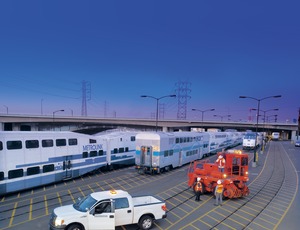
Aimed at preventing rail disasters like the one that killed 79 people in Spain last month, Los Angeles commuter-rail operator Metrolink is installing a sophisticated control system along its 512 miles of track.
The $210.9-million project involves a network of software, signal network updates and communications towers—known as positive train control (PTC)—that will interoperate with similar systems overlayed onto freight-railroad networks operated by United Pacific, Burlington Northern Santa Fe (BNSF) and others.
Metrolink piggybacked on BNSF's 10 years of PTC research, getting a head start at becoming the first U.S. rail network to implement PTC, says Darrell Maxey, Metrolink's PTC, communication and signal systems director.
Fed by data from monitors installed in hundreds of Metrolink locomotives and cab cars—plus more than 200 control points and intermediate signals that can switch trains from one track to another—the system "will know where each train is, how long it is and how long it will take to brake, to make sure it wouldn't allow an over-speed of a curve, turnout or crossover, similar to the unfortunate incident that happened in Spain," Maxey says.
European countries are in the process of installing a similar train control system, but it wasn't yet in place along the route where the Spanish accident occurred.
Parsons, Pasadena, Calif., is tasked with integrating hardware and software developed by multiple vendors and engineering, installing and testing the Metrolink system. "We have to end up with a single system that works, and we have to do it in an environment where all the other railroads that we interface with are doing the same," says Nick LaRocco, the firm's vice president and PTC program manager.
Parsons conducted a comprehensive survey of the rail network and radio, cell-phone and WiFi coverage in the area to create a 3D GIS map used by the control software. Around 200 communications towers were erected to allow for constant real-time monitoring of trains.
The integration of so many different systems means "there is a tremendous amount of testing that's involved," LaRocco says.
Still, the project's complexity has led to delays. Originally planned for completion in early 2013, the system is expected to begin real-world tests in the fall and receive final certification by the Federal Railroad Administration (FRA) in summer 2014. "It has turned out to be more difficult, with a lot of moving parts that have to come together," Maxey says.
Parsons is currently working to install PTC on three other commuter-rail networks across the country. By the end of 2015, all U.S. rail networks are required to have PTC up and running, as mandated by the Rail Safety Improvement Act of 2008. The FRA, however, is recommending that deadline be extended. In June, FRA's administrator, Joseph Szabo, testified before Congress that, because 70,000 miles of track and 20,000 locomotives will have to be equipped with PTC, many railroads "are likely to be challenged by technological and programmatic barriers."
Maxey says the engineering community should prepare to tackle similar projects in rail, highway and other sectors in the future. "You'll see a lot more of these integrated technology projects, so we've got to learn how to manage them and understand the challenges with each part," he adds.


Post a comment to this article
Report Abusive Comment